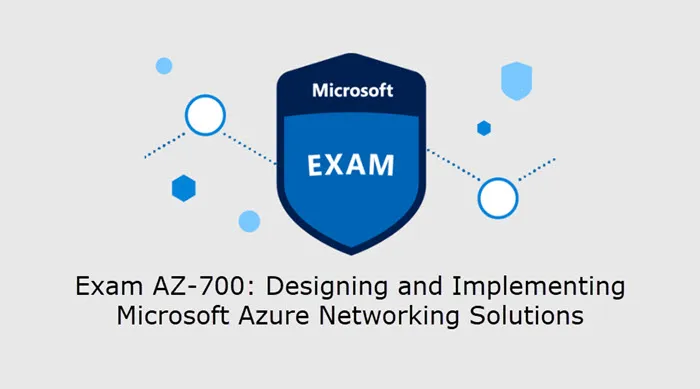
AZ-700 Study Guide Azure Network Engineer
Microsoft Learn provides you with free online training and learning paths for different Microsoft technologies. They not just offer reading material, but also control questions and free online labs. Here are some relevant Microsoft Learn modules and learning paths for the AZ-700 Designing and Implementing Microsoft Azure Networking Solutions Certification Exam. Microsoft Learn is an important part of my AZ-700 Azure Networking solutions exam study guide.
One thing I always used to prepare for my Microsoft exams is Microsoft Docs. Here are the relevant Microsoft Docs which I used to prepare and study for the AZ-700 exam.
Design, Implement, and Manage Hybrid Networking (10–15%)
Design, implement, and manage a site-to-site VPN connection
- Design a site-to-site VPN connection for high availability
- Select an appropriate virtual network (VNet) gateway SKU
- Identify when to use policy-based VPN versus route-based VPN
- Create and configure a local network gateway
- Create and configure an IPsec/IKE policy
- Create and configure a virtual network gateway
- Diagnose and resolve VPN gateway connectivity issues
Design, implement, and manage a point-to-site VPN connection
- Select an appropriate virtual network gateway SKU
- Plan and configure RADIUS authentication
- Plan and configure certificate-based authentication
- Plan and configure OpenVPN authentication
- Plan and configure Azure Active Directory (Azure AD) authentication
- Implement a VPN client configuration file
- Diagnose and resolve client-side and authentication issues
Design, implement, and manage Azure ExpressRoute
- Choose between provider and direct model (ExpressRoute Direct)
- Design and implement Azure cross-region connectivity between multiple ExpressRoute locations
- Select an appropriate ExpressRoute SKU and tier
- Design and implement ExpressRoute Global Reach
- Design and implement ExpressRoute FastPath
- Choose between private peering only, Microsoft peering only, or both
- Configure private peering
- Configure Microsoft peering
- Create and configure an ExpressRoute gateway
- Connect a virtual network to an ExpressRoute circuit
- Recommend a route advertisement configuration
- Configure encryption over ExpressRoute
- Implement Bidirectional Forwarding Detection
- Diagnose and resolve ExpressRoute connection issues
Design and Implement Core Networking Infrastructure (20–25%)
Design and implement private IP addressing for VNets
- Create a VNet
- Plan and configure subnetting for services, including VNet gateways, private endpoints, firewalls, application gateways, and VNet-integrated platform services
- Plan and configure subnet delegation
Design and implement name resolution
- Design public DNS zones
- Design private DNS zones
- Design name resolution inside a VNet
- Configure a public or private DNS zone
- Link a private DNS zone to a VNet
Design and implement cross-VNet connectivity
- Design service chaining, including gateway transit
- Design VPN connectivity between VNets
- Implement VNet peering
Design and implement an Azure Virtual WAN architecture
- Design an Azure Virtual WAN architecture, including selecting SKUs and services
- Connect a VNet gateway to Azure Virtual WAN
- Create a hub in Virtual WAN
- Create a network virtual appliance (NVA) in a virtual hub
- Configure virtual hub routing
- Create a connection unit
Design and Implement Routing (25–30%)
Design, implement, and manage VNet routing
- Design and implement user-defined routes (UDRs)
- Associate a route table with a subnet
- Configure forced tunneling
- Diagnose and resolve routing issues
Design and implement an Azure Load Balancer
- Choose an Azure Load Balancer SKU (Basic versus Standard)
- Choose between public and internal
- Create and configure an Azure Load Balancer (including cross-region)
- Implement a load balancing rule
- Create and configure inbound NAT rules
- Create explicit outbound rules for a load balancer
Design and implement Azure Application Gateway
- Recommend Azure Application Gateway deployment options
- Choose between manual and autoscale
- Create a back-end pool
- Configure health probes
- Configure listeners
- Configure routing rules
- Configure HTTP settings
- Configure Transport Layer Security (TLS)
- Configure rewrite policies
Implement Azure Front Door
- Choose an Azure Front Door SKU
- Configure health probes, including customization of HTTP response codes
- Configure SSL termination and end-to-end SSL encryption
- Configure multisite listeners
- Configure back-end targets
- Configure routing rules, including redirection rules
Implement an Azure Traffic Manager profile
- Configure a routing method (mode)
- Configure endpoints
- Create HTTP settings
Design and implement an Azure Virtual Network NAT
- Choose when to use a Virtual Network NAT
- Allocate public IP or public IP prefixes for a NAT gateway
- Associate a Virtual Network NAT with a subnet
Secure and Monitor Networks (15–20%)
Design, implement, and manage an Azure Firewall deployment
- Design an Azure Firewall deployment
- Create and implement an Azure Firewall deployment
- Configure Azure Firewall rules
- Create and implement Azure Firewall Manager policies
- Create a secure hub by deploying Azure Firewall inside an Azure Virtual WAN hub
- Integrate an Azure Virtual WAN hub with a third-party NVA
Implement and manage network security groups (NSGs)
- Create an NSG
- Associate an NSG to a resource
- Create an application security group (ASG)
- Associate an ASG to a NIC
- Create and configure NSG rules
- Interpret NSG flow logs
- Validate NSG flow rules
- Verify IP flow
Implement a Web Application Firewall (WAF) deployment
- Configure detection or prevention mode
- Configure rule sets for Azure Front Door, including Microsoft managed and user defined
- Configure rule sets for Application Gateway, including Microsoft managed and user defined
- Implement a WAF policy
- Associate a WAF policy
Monitor networks
- Configure network health alerts and logging by using Azure Monitor
- Create and configure a Connection Monitor instance
- Configure and use Traffic Analytics
- Configure NSG flow logs
- Enable and configure diagnostic logging
- Configure Azure Network Watcher
Design and Implement Private Access to Azure Services (10–15%)
Design and implement Azure Private Link service and Azure Private Endpoint
- Create a Private Link service
- Plan private endpoints
- Create private endpoints
- Configure access to private endpoints
- Integrate Private Link with DNS
- Integrate a Private Link service with on-premises clients
Design and implement service endpoints
- Create service endpoints
- Configure service endpoint policies
- Configure service tags
- Configure access to service endpoints
Configure VNet integration for dedicated platform as a service (PaaS) services
- Configure App Service for regional VNet integration
- Configure Azure Kubernetes Service (AKS) for regional VNet integration
- Configure clients to access App Service Environment



